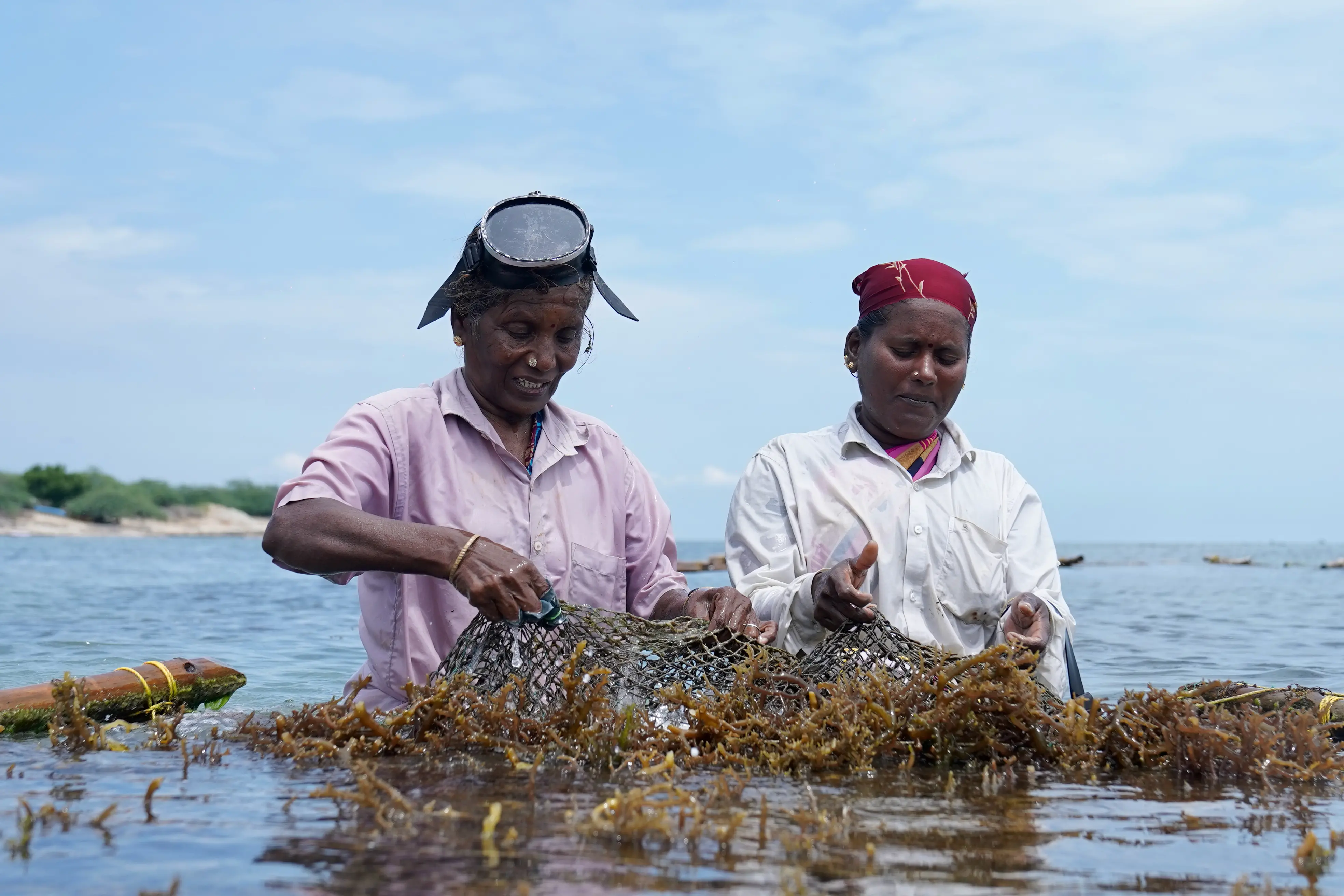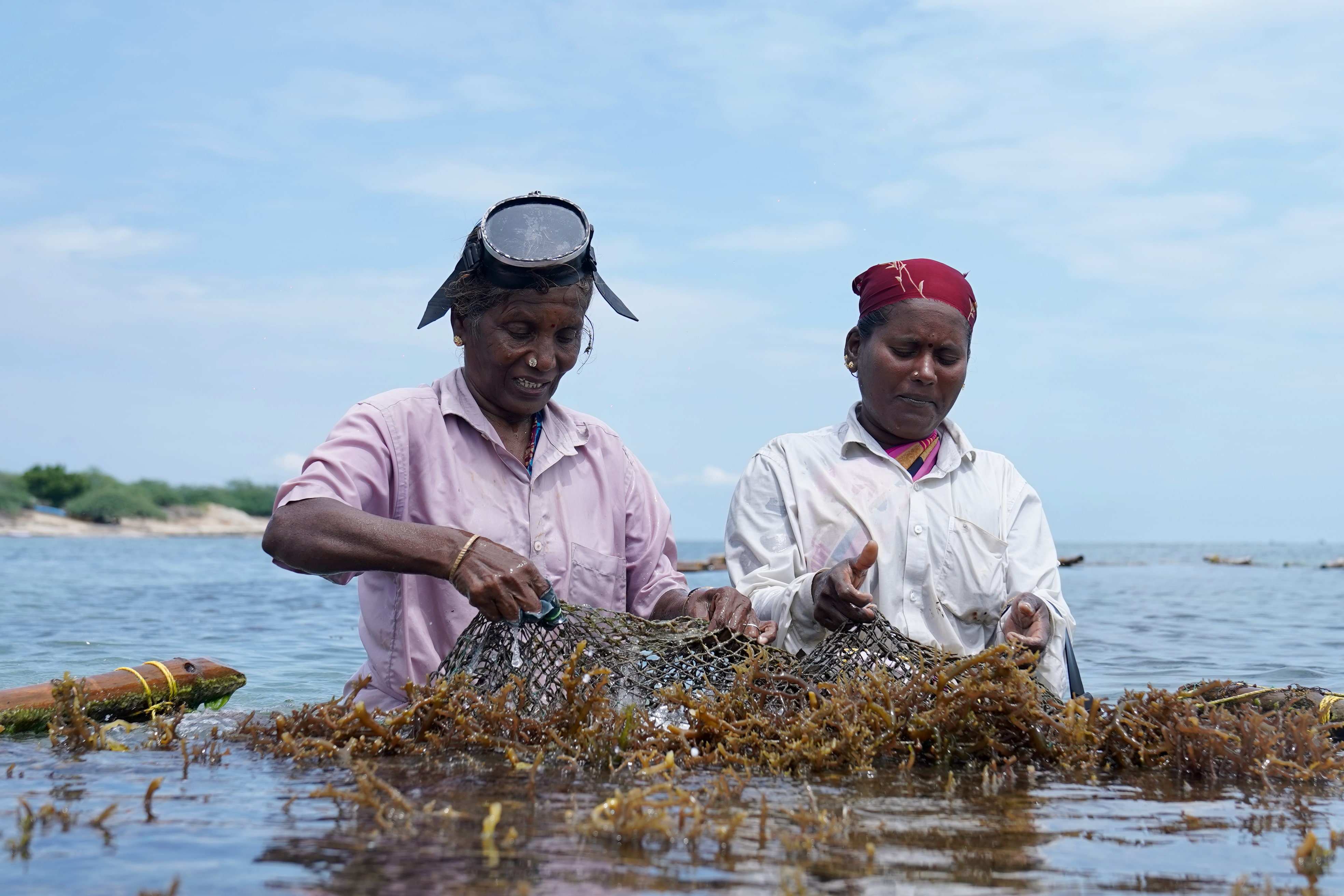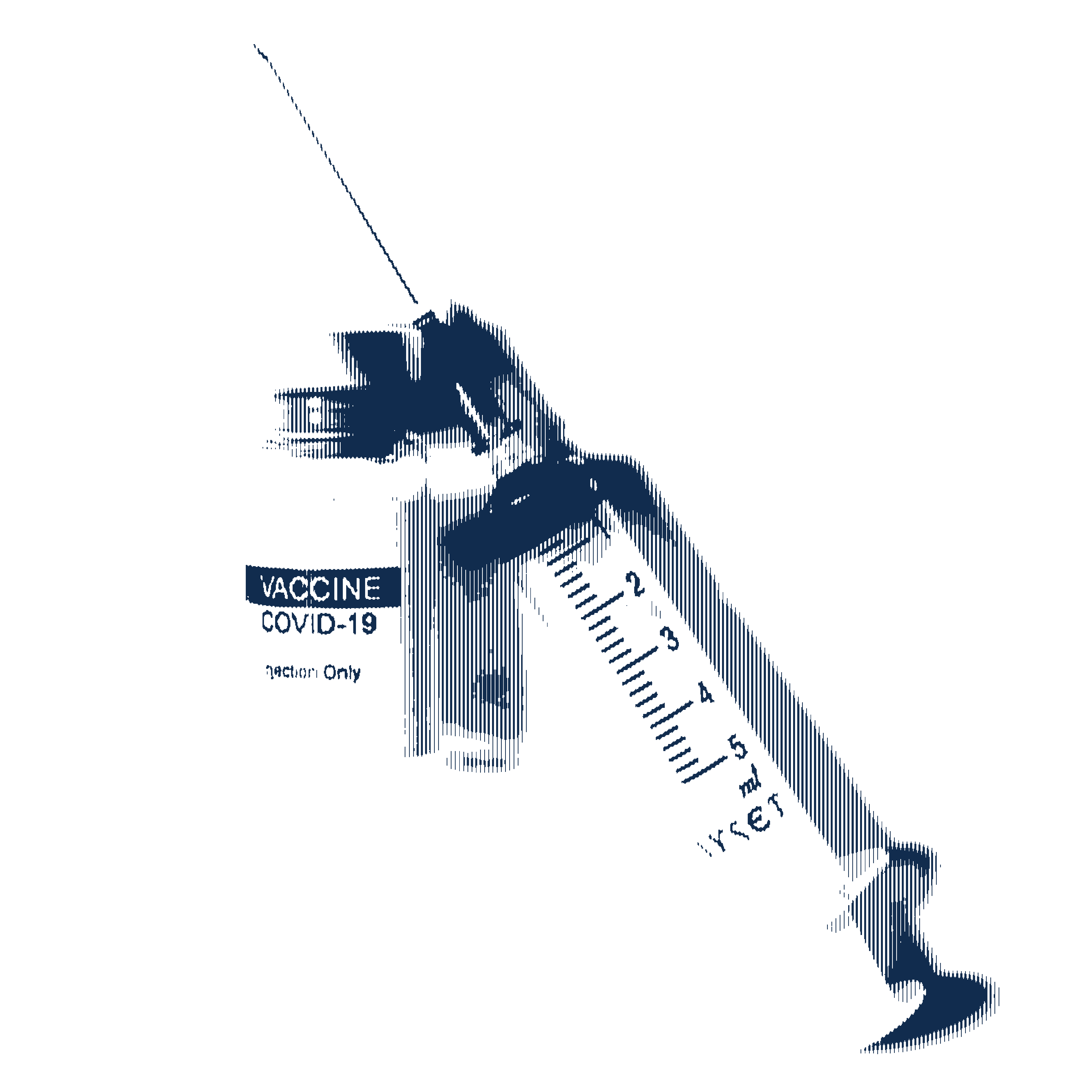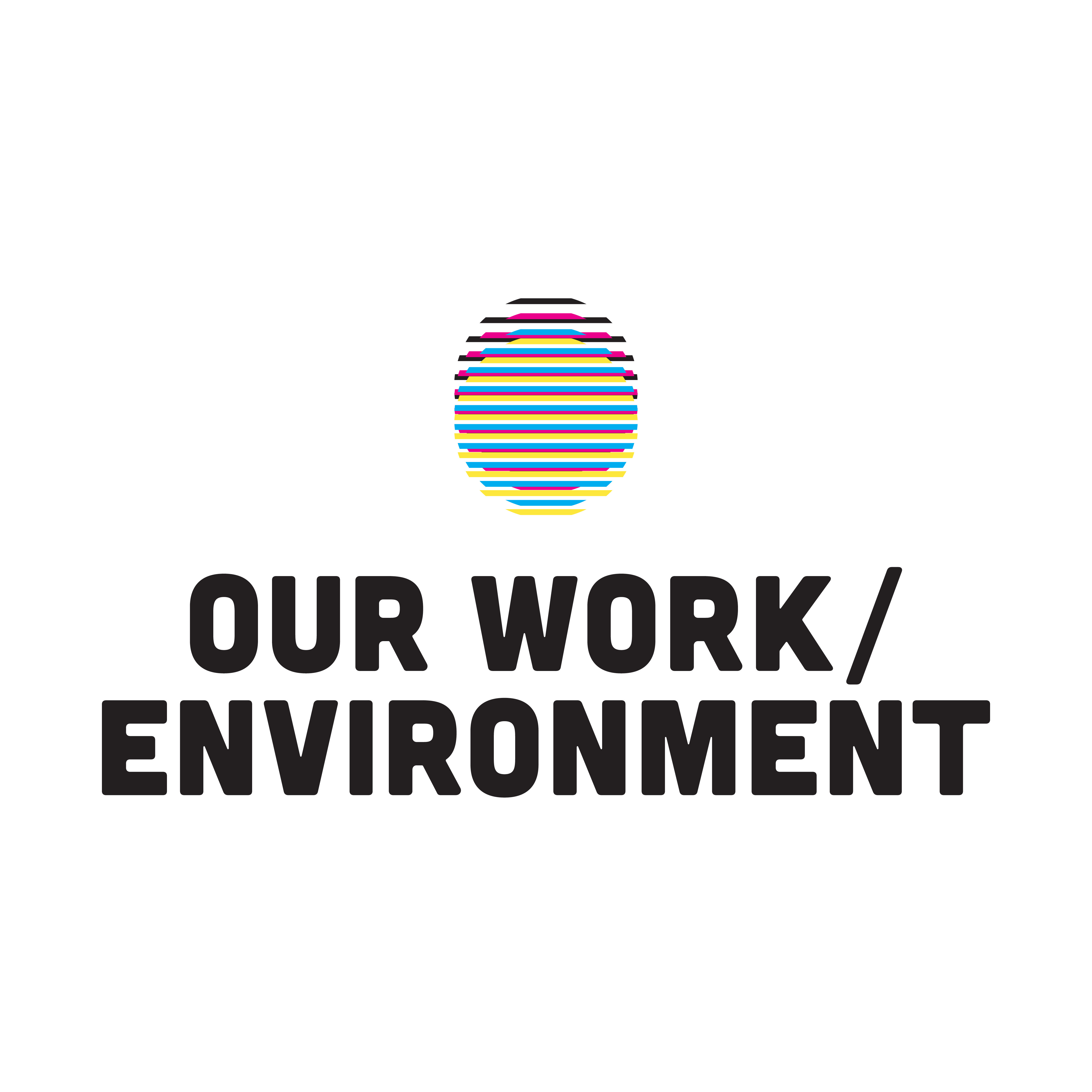
CHENNAI, INDIA—Mutha’s sari fills up like a pink water balloon as she drags herself against the current of the sea. Standing in the shallow waters near the coast, she peers below for a few moments, through her thick plastic goggles, and takes a dip, emerging with a clump of greenish seaweed, called marikolunthu pasi in Tamil.
The 44-year-old from Rameswaram is a seaweed farmer, someone who grows the red algae in these waters of the Bay of Bengal, and sells it to factories that process it. A little distance away are bamboo rafts on which is growing a rubber-like weed, in shades of green, brown and maroon. Mutha slowly paddles over to the heavy rafts and gives them a shake. “This pasi (seaweed) is different. It does not like any dirt, so we make sure there is no sand around it.” In a few more weeks, the weed will grow to its full height, when she will collect it and dry it in the sun.
When Mutha was a child, she never spotted this seaweed growing in these parts. It is a foreign species, called Kappaphycus alvarezii. “But, even a few years ago, rafts and rafts of this pasi (seaweed) would cover most of the seawater around here,” says Mutha, who lives in Narrikulli village in Rameswaram, about 20 minutes away by boat from the Rameswaram lighthouse.
The story of how the algae came to be grown in these waters goes back decades. In the 1980s, a Gujarat-based government agency, Central Salt and Marine Chemicals Research Institute (CSMCRI), brought a fragment of the weed from Japan to India as an experiment. “The weather and water quality conditions in India were thought to be conducive for extensive commercial cultivation in India-like conditions. [We thought] this would help the coastal community fetch additional income, and that industries could benefit from processing seaweed,” a CSMCRI spokesperson told Mint over email.
In the early 2000s, Pepsico spotted an opportunity. It ran a programme to motivate farmers of Rameswaram to grow the algae, which is processed to yield carrageenan—a jelly-like thickening, sweetening and stabilizing agent used in numerous products, from toothpaste to ice cream, confectionaries and medicines. Carrageenan is used in the food and beverage industry because of its superior gel-like and thickening properties. Till 2008, Pepsi ran a 7.2 acre seaweed cultivation project in coastal areas of Tamil Nadu, informally contracting farmers like Mutha to grow and collect seaweed. It would export the seaweed to processing firms in South-east Asia, to be turned into a gel-like substance or powder.
For those struggling with uncertain incomes from fishing, this was a godsend. They found new employment and support. For Mutha, a single mother, the income from the seaweed farming helped put her son through school and college. The farmers began to call this foreign weed ‘Pepsi pasi’.
But abruptly, a few years ago, the seaweed stopped growing. Incomes crashed, many quit the business. Pepsico shut down its seaweed business in 2008, when Abhiram Seth, the manager who ran the Tamil Nadu project, acquired it from the multinational and set up his own company, Aquagri. Till 2014, about 2,000 farmers were involved in Kappaphycus cultivation, says Seth. Now, there are only 200-300 farmers all across Tamil Nadu, which is the only state that commercially grows seaweed. India produced about 34,000 tonnes of seaweed in 2021, according to the estimates of the Central Marine Fisheries Research Institute (CMFRI). It plans to increase it to 11.2 lakh tonnes by 2025.
Farmers like Mutha pin their hopes on a revival. Some want the government to import another fragment of Pepsi pasi to set up more seaweed farms. But it’s here that a section of the scientific community raises a red flag. Kappaphycus alvarezii, they point out, is listed as an invasive species by the IUCN, and its cultivation could endanger India’s precious coral reefs, especially in the Gulf of Mannar region.
Businessmen and institutes like the CSMCRI, however, have been pushing the government to allow seaweed farming in those areas. “The central government is promoting seaweed cultivation. But some quarters like the ministry of environment and climate change have concerns,” said senior principal scientist Arup Ghosh of CSMCRI.
Native versus exotic
In 2002, after years of experiments, Kappaphycus alvarezii was finally released for commercial cultivation near Mandapam, Rameswaram, in Tamil Nadu. But in 2008, the weed was reported to have escaped the site of cultivation and was found growing on some branching corals at the nearby island of Krusadai in the Gulf of Mannar.
Coral reefs, often known as the rainforests of the oceans, are critical in protecting the coastlines and the marine life. In India, the Gulf of Mannar is one of the four regions where corals are found. Corals around the coasts of Mannar are already stressed due to anthropogenic and environmental factors. Finding an exotic entity growing on the corals led to an uproar in the environmental community.
A team representing the forest department and independent scholars visited the island soon after. Marine biologist Naveen Namboothri, the founder of NGO Dakshin Foundation, was part of the team. “The weed was found to be smothering the corals,” he says. In December 2005, the government of Tamil Nadu issued orders, warning against the invasive potential of Kappaphycus, and directed that cultivation should be limited only to the north of Palk Bay and south of Tuticorin coast.
In 2015, a similar incident was reported again—Kappaphycus had started growing on a coral in another region of Mannar. The state government carried out another drive to pluck out colonies of seaweed from the surface of corals. According to Namboothri, that effectively meant that “the entire coral reef would be damaged.”
Scientists at CSMCRI, however, argue that Kappaphycus is a native species because it has been reported in the Andaman and Nicobar Islands before. Some researchers believe that the Andamans are too far from mainland India to tag it as native. Moreover, other researchers like S. Sandilyan, former fellow on invasive alien species at the Centre for Biodiversity Policy and Law (CEBPOL), National Biodiversity Authority (NBA), advise great caution. “The available results/studies across the continent clearly emphasized the invasive potential of the species in their introduced sites, including India,” Sandilyan said. “A small fragment is enough for forming a colony, just as we see in the case of water hyacinth,” he says. The sea doesn’t have boundaries like land. He warned that the “continuous tidal action” of the ocean could transport invasive species to ecologically vulnerable areas, with serious consequences.
The mystery disease
But it was not only a scientific debate that struck a blow to Mutha’s fortunes as a seaweed farmer.
Indeed, soon after the commercial cultivation of Kappaphycus started in Rameswaram in the early 2000s, its production multiplied manifold. From 21 dry tonnes in 2001, it rose to 1,490 dry tonnes in 2013. For farmers, the selling price, too, went up from ₹4 a kilo to ₹35 a kilo.
But the very next year, disaster struck. Kappaphycus faced mass mortality. The seaweed died across the region. During 2013- 2014, the production dropped by close to 90 %. Scientists like Vaibhav Mantri from CSMCRI are still not sure about the reasons behind these events. “One reason could be an episode of extreme heat,” says Mantri. The scientist and others in the business also say that the cultivation suffered because of “losing vigour of the germplasm. ”
Earlier, 100-150 gm of Pepsi pasi was enough to yield 2-3 kg of seaweed. From the size of a pea pod, the pasi would grow as big as a pumpkin within 25 days. Mutha remembers the first time she grew Pepsi pasi, around 2004. It grew up to her height. “It was so heavy, thriving with life. And now it just does not grow anymore.” Now, it may take more than 45 days and, in the worst-case scenario, about 3 months to grow well. The quality has dwindled and so have incomes. “Look at the inflation. Even one gas cylinder costs ₹1,200 and above all, there isn’t much pasi left,” says Mutha.
With the exit of Pepsico, several organizations procure the seaweed from the farmers and then export it overseas. Abhiram Seth’s AquAgri dominates the market. Before the seaweed farms moved from Pepsico to AquAgri, PepsiCo India Holdings Private Ltd had paid a sum of ₹3.7 million to the Tamil Nadu Biodiversity Board—to access the exotic Kappaphycus alvarezii—as part of access and benefit sharing.
For farmers, this remains arduous work, with little support. Sometimes, they have found NGOs helping out with training or personal protection equipment, like hats. “Like the ones they wear in movies, with ropes hanging on each side,” says Mutha.
The last time they got those hats was 10 years ago. “They are torn now.”
The locals have devised solutions for their work hazards. A red piece of cloth protects Mutha’s head from the sizzling summer sun, an oversized shirt protects her from the bites of sonapuchi—a small hair-like insect that often bites and leaves behind scratches, irritation and white spots. “Some say it’s poisonous, but not for us,” she says
Her hands are heavy, with rags wrapped around her fingers, held together by plastic rubber bands of red, black and blue. “The fingers often get blistered while working on the weeds. Sometimes the fingers bleed at night. Cooking is a hard task, but eating is harder. When you plunge these fingers in hot rice, it stings,” she says.
Other farmers from nearby villages—Radha from Sambai village and Murugeshan from nearby Mandapam—began pasi farming like Mutha in the early 2000s. It provided a decent livelihood, encouraging them to get out of fishing, which is no longer a reliable income support.
A combination of factors like overfishing, pollution, introduction of mechanized boats, subsidies and climate change had led to a fall in the fish population in the sea. In 1992-93, the CMFRI reported over 2.2 million tonnes of fish catch, which fell to 0.6 million tonnes by 2013-14. Neither Radha nor Murugeshan farms seaweed any more. Radha has ventured into the more lucrative octopus farming and Murugeshan has gone back to fishing trawlers.
The road ahead
According to CSMCRI, farmers and businessmen, the import of a new germplasm—a new fragment of seaweed from one of the countries where it is found in abundance—is imperative to keep the business alive. Other Asian countries like the Philippines, Indonesia, Vietnam, and Malaysia are the leading producers of carrageenan-filled Kappaphycus in the world. “Boundaries are political, they are not environmental. The government needs to allow cultivation in the Gulf of Mannar, and allow import of fresh germplasm from countries like Indonesia and Philippines,” says AquAgri’s Seth.
The import has not been allowed by the ministry of environment, forest and climate change (MoEFCC) yet, although industries are coming up with proposals for large-scale production of seaweed near Gulf of Mannar. Mint sent several queries to the MoEFCC and the ministry of agriculture and farmers’ welfare, but the government did not respond to the questions. While the economic value of seaweed is beyond doubt, the evidence that it is safe for the ecosystem is still not clear.
For Mutha, there is little to be done except wait for the tide to turn on Pepsi pasi. The only hope she has right now is for the prices of the seaweed to go up or for her son to secure a better job.










